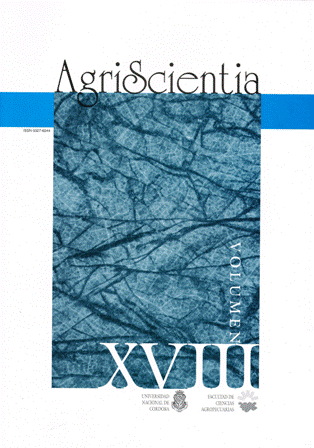Biological and reproductive aspects of Piezodorus guildinii (West.) (Hemiptera: Pentatomidae) under laboratory conditions
Main Article Content
Abstract
Aspects of the life cycle, reproduction and mortality of Piezodorus guildinii (Westwood) were evaluated under laboratory conditions: temperature = 24.9 ± 0.5 °C; relative humidity = 53.6 ± 7.9 % and 16-hour photophase. Insects were fed with fresh fruits of Phaseolus vulgaris (L.). Survival and fecundity were calculated, and the following population parameters were estimated: net reproductive rate (R₀), generation time (T), intrinsic rate of natural increase (r), finite rate of increase (λ), and reproductive value (Vₓ). Mean time from oviposition to adult was 32 days. Nymphal mortality was 60.1 %, with the highest values in the second nymphal instar. Adult longevity was 60 and 78.5 days in males and females, respectively, without significant differences (p > 0.05) between sexes; the sex ratio was 1.3 females : 1 male. Mean number of eggs per female was 86.33; each female laid 8.5 egg masses with an average of 9.5 eggs per mass. Other results were: R₀ = 7.45 females/female in a generation; T = 88.3 days; r = 0.023 and λ = 1.02 individuals/female. The greatest reproductive value was recorded during the 9th week.
Article Details
Issue
Section

This work is licensed under a Creative Commons Attribution-ShareAlike 4.0 International License.
How to Cite
References
Aragón, J.; A. Molinari; S. Diez de Lorenzatti, 1997. Manejo Integrado de Plagas. Cap. 12: 247-308. En: El cultivo de la soja en Argentina. Editores: Laura M. Giorda y Héctor E. J. Baigorri. INTA, Centro Regional Córdoba.
Ávalos, D. S.; N. C. La Porta, 1996. Biología de Acrosternum bellum Rolston, 1983 (Hemiptera, Pentatomidae). AGRISCIENTIA XIII: 25-30.
Ávalos, D. S.; N. C. La Porta, 2001. Aspectos biológicos y parámetros poblacionales de Edessa meditabunda (Hemiptera: Pentatomidae) bajo condiciones controladas. Rev. Soc. Entomol. Argent. 60 (1-4): 177-182.
Fraga, C. P.; L. H. Ochoa, 1972. Aspectos morfológicos y bioecológicos de Piezodorus guildinii (West.) (Hemiptera, Pent.). I.D.I.A. Supl. 28: 103-117.
Harris, V. E.; J. W. Todd, 1981. Rearing the southern green stink bug, Nezara viridula, with relevant aspects of its biology. J. Georgia Entomol. Soc. 16 (2): 203-210.
La Porta, N. C.; I. S. de Crouzel, 1984. Estudios básicos para el control biológico de Nezara viridula (L. 1758) (Hemiptera, Pentatomidae) en la Argentina. Rev. Soc. Entomol. Argent. 43 (1-4): 119-143.
La Porta, N. C.; D. S. Ávalos, 1993. Aspectos biológicos de Acrosternum apicicorne (Spinola, 1862) (Hemiptera, Pentatomidae). AGRISCIENTIA X: 45-49.
Liljesthröm, G., 1983. Algunos aspectos de la demografía de Nezara viridula (L.) (Hemiptera, Pentatomidae) en condiciones de laboratorio. Rev. Soc. Entomol. Argent. 42 (1-4): 383-396.
Panizzi, A. R., 1987. Impacto de leguminosas na biología de ninfas e efeito da troca de alimento no desempenho de adultos de Piezodorus guildinii (Hemiptera: Pentatomidae). Rev. Brasil. Biol. 47 (4): 585-591.
Panizzi, A. R., 1992. Performance of Piezodorus guildinii on four species of Indigofera legumes. Entomol. Exp. Appl. 63: 221-228.
Panizzi, A. R., 1997. Wild host of pentatomids: Ecological significance and role in their pest status on crops. Annu. Rev. Entomol. 42: 99-122.
Panizzi, A. R.; F. Slansky Jr., 1985a. Review of phytophagous pentatomids (Hemiptera: Pentatomidae) associated with soybean in the Americas. Fla. Entomol. 68 (1): 184-214.
Panizzi, A. R.; F. Slansky Jr., 1985b. Legume host impact on performance of adult Piezodorus guildinii (Westwood) (Hemiptera: Pentatomidae). Environ. Entomol. 14: 237-242.
Rabinovich, J., 1980. Introducción a la ecología de poblaciones animales. C.E.C.S.A., México. 109 pp.
Rizzo, H., 1976. Hemípteros de interés agrícola. Chinches perjudiciales y chinches benéficas para los cultivos. Edit. Hemisferio Sur S. R. L., Bs. As. 69 pp.
Sokal, R.; J. Rohlf, 1969. Biometría. Principios y métodos estadísticos en la investigación biológica. H. Blume, Madrid. 832 pp.





